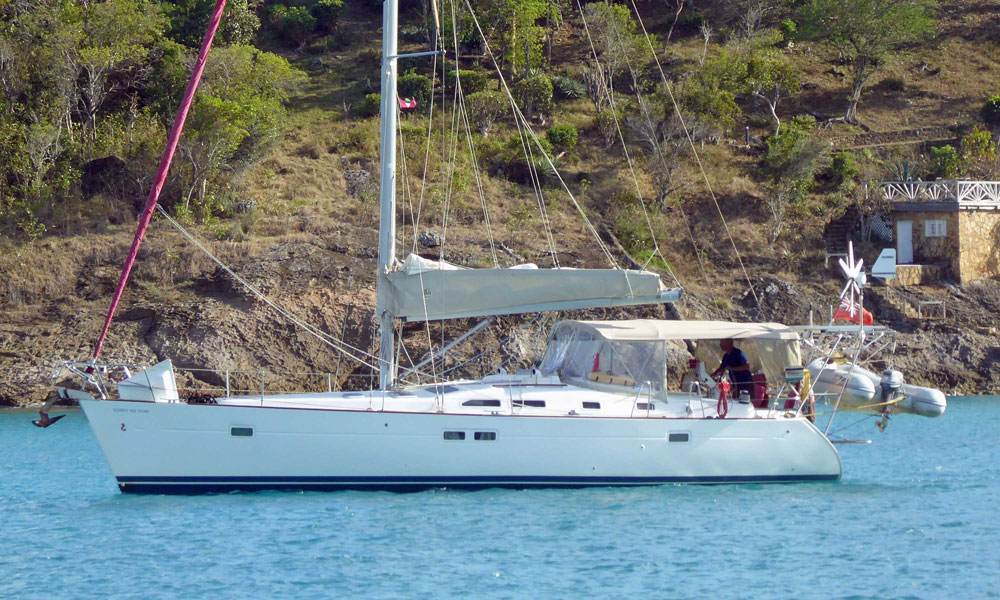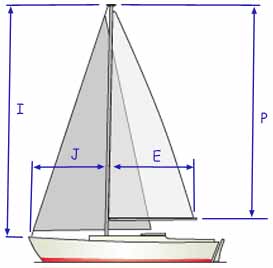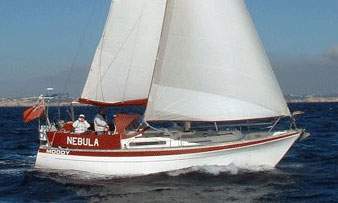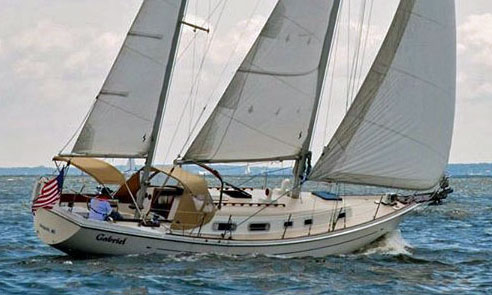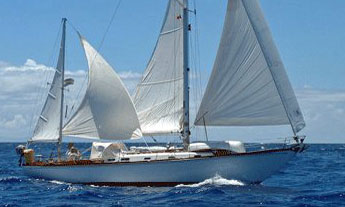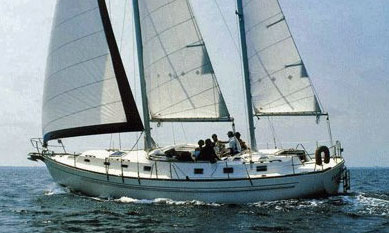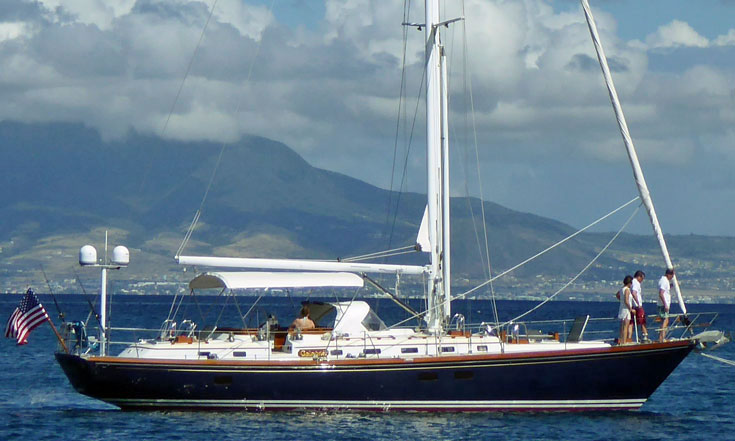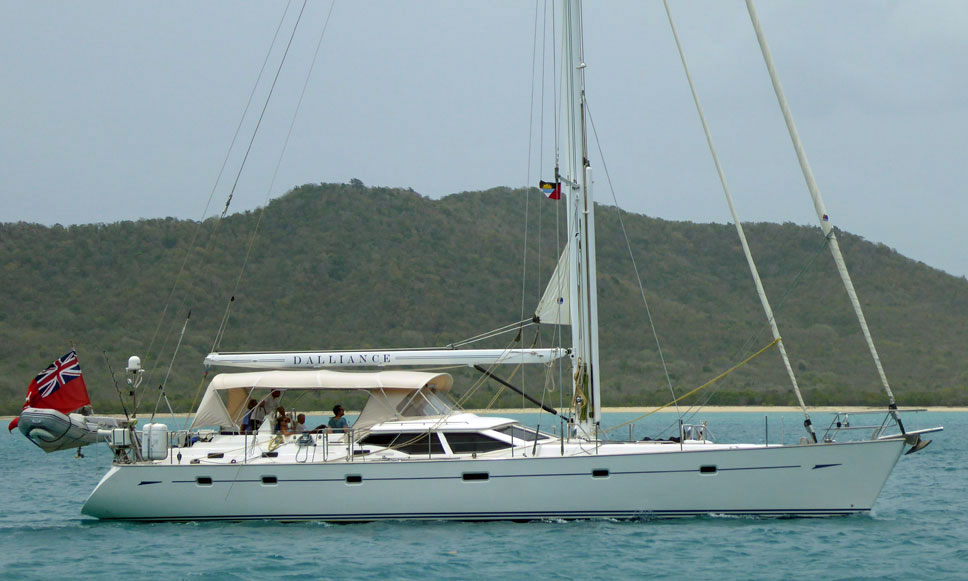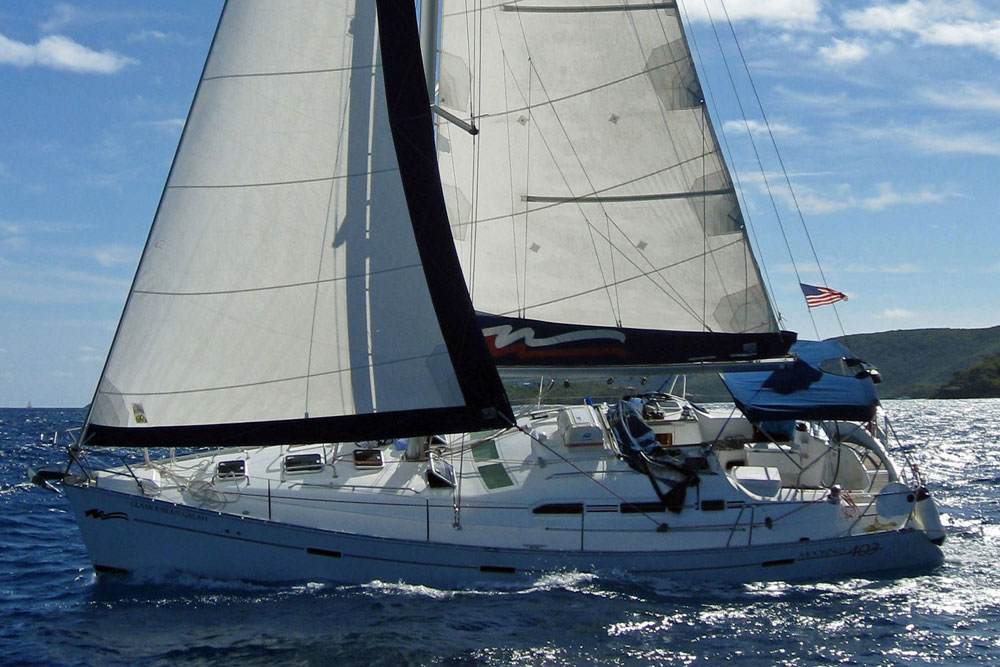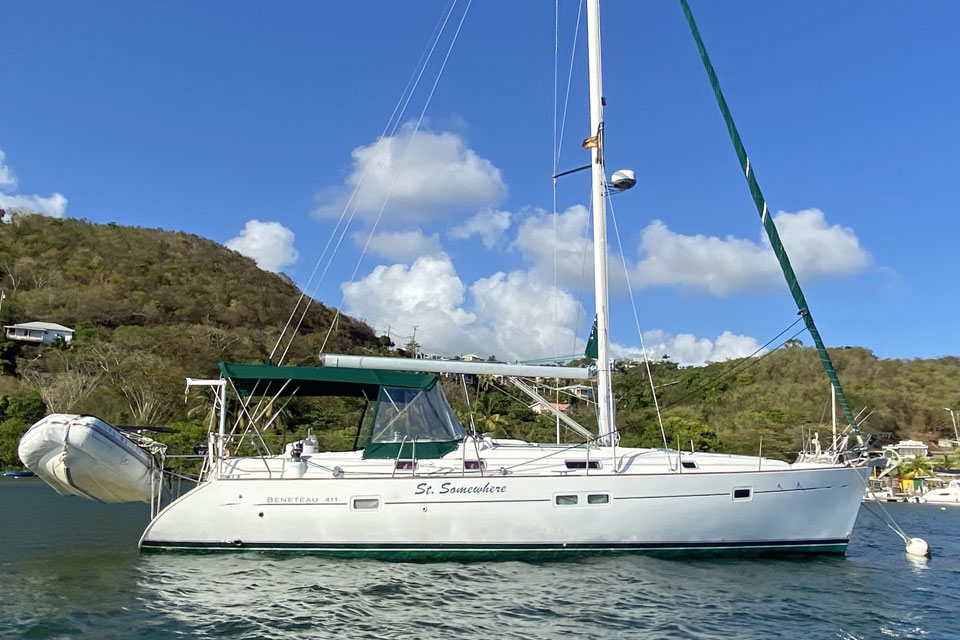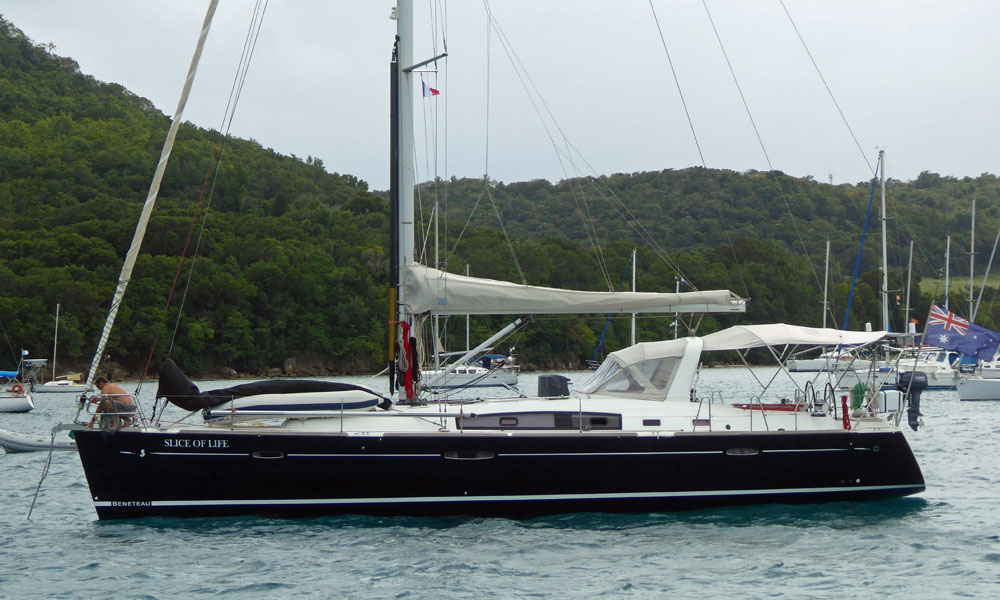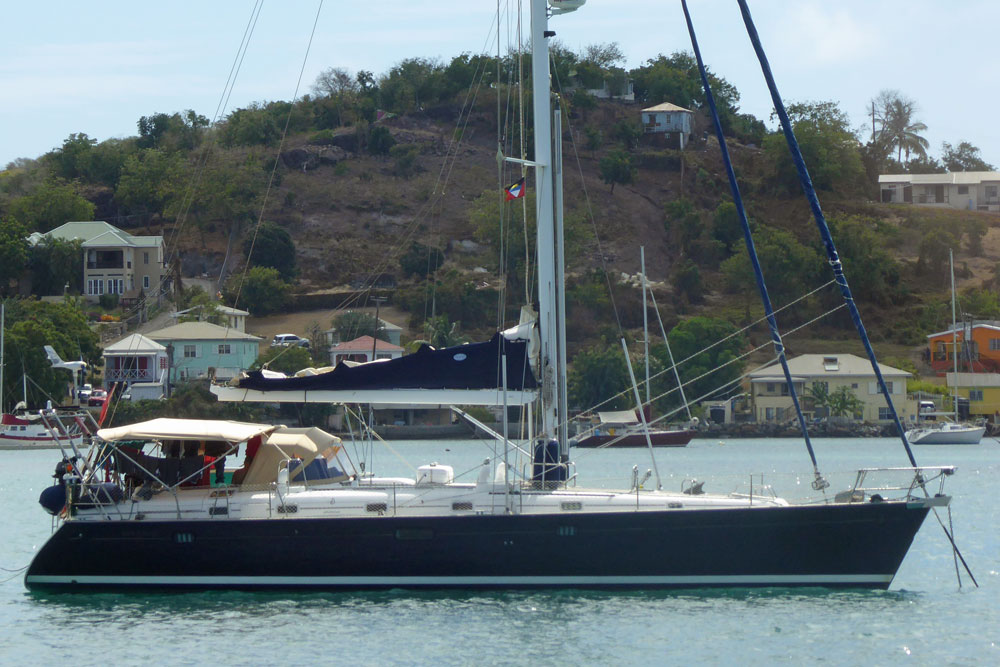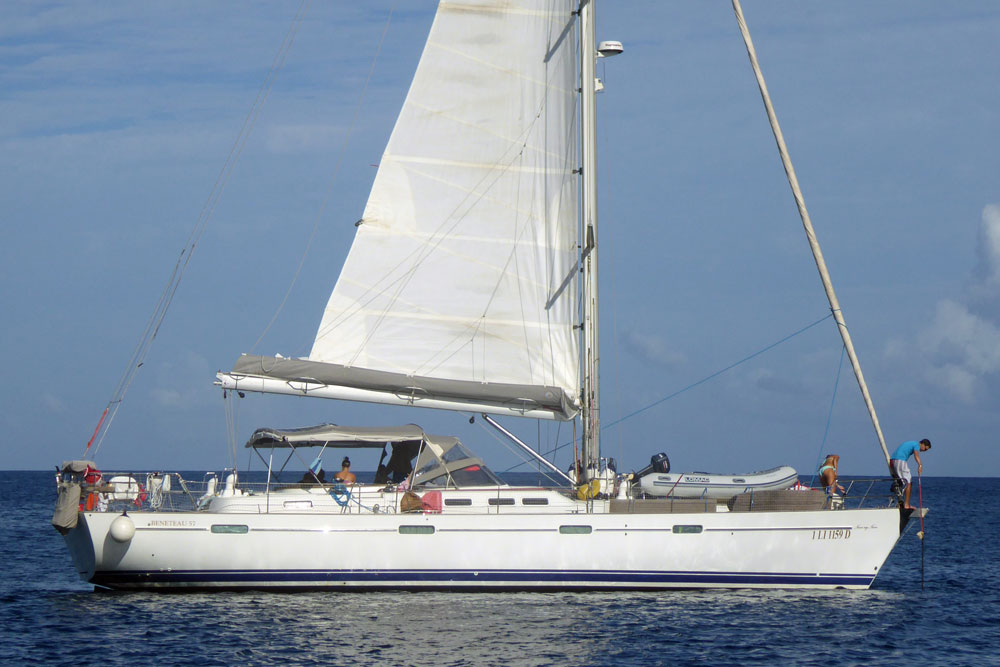- Home
- Cruising Yachts 40' to 45'
- Beneteau 423
The Beneteau 423 Sailboat
Specs & Key Performance Indicators
The Beneteau 423, a masthead sloop, was designed by Groupe Finot and built in France by Beneteau.
Published Specification for the Beneteau 423
Keel & Rudder Configuration: Fin keel with bulb and spade rudder
Hull Material: Fiberglass (GRP)
Length Overall: 43'2" (13.1m)
Waterline Length: 38'6" (11.8m)
Beam: 12'11" (3.9m)
Draft: 5'7" (1.7m)
Rig Type: Masthead Sloop
Displacement: 19,500lb (8,845kg)
Ballast: 5,836 lbs (2,647 kg)
Water Tank Capacity: 154 US gallons (580 litres)
Fuel Tank Capacity: 53 US gallons (200 litres)
Hull Speed: 8.32 knots
Designer: Groupe Finot
Builder: Beneteau
Year First Built: 2002
Options & Alternatives
Draft Options
- Standard Draft: 5'7" (1.70 m)
- Deep Draft: 6'11" (2.10 m)
Interior Layout Options
- Two-Cabin Layout: This layout featured a spacious owner's cabin forward with an en-suite head, a large aft cabin, and a single head.
- Three-Cabin Layout: This layout included an additional cabin, making it suitable for larger crews or families. It typically had a forward cabin, two aft cabins, and two heads.
The Beneteau Oceanis Clipper 423
- Standard Equipment: The Oceanis Clipper 423 came with a list of optional equipment as standard, making it a more fully equipped variant compared to the original Beneteau 423.
- Interior Layouts: Both versions offered the same two-cabin and three-cabin layout options, but the Clipper version often included more luxurious finishes and additional amenities.
Sail Areas & Rig Dimensions
Sail Area (100% Foretriangle): 720ft2 (66.9m2)
I (foretriangle height): 50'6" (15.40m)
J (foretriangle base): 14'9" (4.50m)
P (mainsail luff length): 44'3" (13.50m)
E (mainsail foot length): 15'1" (4.60m)
where
- “I” is measured along the front of mast from the highest halyard to the main deck. The main deck is where the deck would be if there were no deckhouse;
- “J” is the base of the foretriangle measured along the deck from the headstay to the mast;
- “P” is the luff length of the main-sail, measured along the aft face of the mast from the top of the boom to the highest point that the mainsail can be hoisted;
- “E” is the foot length of the main-sail, measured along the boom from the after face of the mast to the outermost point on the boom to which the main can be pulled.
Published Design Ratios
The Key Performance Indicators (KPIs)
Sail Area/Displacement Ratio: 19.1
Ballast/Displacement Ratio: 29.9%
Displacement/Length Ratio: 152
Comfort Ratio: 25.0
Capsize Screening Formula: 1.9
The following analysis of the primary design ratios gives an indication of the boat's likely sailing characteristics, but see the 'Notes of Caution' that follow below:
- Sail Area/Displacement Ratio (19.1): This ratio suggests that the Beneteau 423 will, in the right conditions, approach her maximum hull speed readily and satisfy the sailing performance expectations of most cruising sailors.
- Ballast/Displacement Ratio (29.9%): This ratio would usually mean that the Beneteau 423 would have a tendency to heel excessively in a gust, and need to be reefed early to keep her sailing upright in a moderate breeze. However, as she has much of her ballast concentrated in a bulb at the foot of the keel, she's likely to be considerably stiffer than her Ballast/Displacement Ratio might suggest.
- Displacement/Length Ratio (152): This places the Beneteau 423 in the light displacement category. Boats in this range are generally easier to drive to their hull speed and are more responsive. The Beneteau 423 should feel lively and agile, making it enjoyable to sail. But if she's loaded with too much heavy cruising gear her performance will suffer dramatically.
- Comfort Ratio (25.0): This ratio indicates a somewhat lively motion, typical of a coastal cruiser with moderate stability. The Beneteau 423 should provide a comfortable ride in most conditions, though it may feel more active in rougher seas compared to heavier bluewater cruisers.
- Capsize Screening Formula (1.9): A value below 2.0 suggests that the Beneteau 423 is well-suited for ocean passages and has good bluewater capability. This low value indicates a lower risk of capsize, making it a safe choice for extended cruising.
Overall, the Beneteau 423 is a well-rounded cruiser with good performance, moderate stability, and comfort, suitable for both coastal and bluewater sailing.
Design Ratios: Notes of Caution...
- The Sail Area/Displacement Ratio (SA/D): This ratio provides an estimate of the sail power relative to the boat's weight, which can indicate potential speed in various wind conditions. But it doesn't account for the efficiency of the sail plan, the rigging, or the skill of the crew. Real-world performance can vary significantly based on these factors.
- The Ballast/Displacement Ratio (B/D): This ratio gives an idea of the boat's stability and stiffness, which is crucial for handling and safety. But it doesn't consider the distribution of the ballast or the hull shape, both of which can greatly affect stability. A high B/D ratio alone doesn't guarantee a stable boat if the ballast is poorly distributed.
- The Displacement/Length Ratio (D/L): This ratio helps predict the boat's speed potential and its behaviour in different sea conditions. But it doesn't account for the hull design or the boat's overall weight distribution. Two boats with the same D/L ratio can perform very differently if their hull shapes are different.
- The Comfort Ratio (CR): This ratio estimates the boat's motion comfort in a seaway, which is important for long passages. But it doesn't consider the boat's interior layout, which can also affect comfort. Additionally, personal tolerance to motion varies, so a boat that is comfortable for one person might not be for another.
- The Capsize Screening Formula (CSF): This formula assesses the likelihood of a boat capsizing in heavy seas, which is critical for offshore safety. But it doesn't take into account the boat's handling characteristics or the skill of the crew. A boat with a low CSF can still capsize if poorly handled in severe conditions.
General Limitations
- Static Nature: These ratios are static measurements and don't account for dynamic factors like wave action, wind gusts, or crew actions.
- Simplification: They simplify complex interactions into single numbers, which can be misleading. Real-world performance is influenced by a multitude of factors that these ratios can't fully capture.
- Context: The context in which the boat is used (e.g., coastal cruising vs. offshore racing) can greatly affect how these ratios should be interpreted.
In summary, while these ratios provide valuable insights into the theoretical performance characteristics of a sailboat, they should be used as part of a broader assessment that includes practical experience, sea trials, and expert advice.
More Specs & Key Performance Indicators for Popular Cruising Boats
This article was written with the assistance of Gemini, a large language model developed by Google. Gemini was used to gather information, summarize research findings, and provide suggestions for the content and structure of the article.
Other sailboats in the Beneteau product range include:
Recent Articles
-
Is Marine SSB Still Used?
Apr 15, 25 02:05 PM
You'll find the answer to this and other marine SSB-related questions right here... -
Is An SSB Marine Radio Installation Worth Having on Your Sailboat?
Apr 14, 25 02:31 PM
SSB marine radio is expensive to buy and install, but remains the bluewater sailors' favourite means of long-range communication, and here's why -
Correct VHF Radio Procedure: Your Questions Answered
Apr 14, 25 08:37 AM
Got a question about correct VHF radio procedure? Odds are you'll find your answer here...
